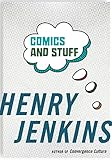Comics and Stuff / Henry Jenkins.
Material type: TextPublisher: New York, NY : New York University Press, [2020]Copyright date: ©2020Description: 1 online resource : 104 color illustrationsContent type:
TextPublisher: New York, NY : New York University Press, [2020]Copyright date: ©2020Description: 1 online resource : 104 color illustrationsContent type: - 9781479852741
- 9781479831258
- SOCIAL SCIENCE / Media Studies
- Alice in Wonderland
- Animation history
- Cabinet d'amateur
- Caricature
- Chicago
- Collage
- Crooners
- Culling
- Display
- Early comic strips
- Early photography
- Graphic novels
- Happy objects
- Homosocial Relations
- Local History
- Meaning
- Memory
- Midcentury Podern
- Music hall
- Nostalgia
- Racism
- Relic
- Rituals
- Senior citizens
- Southern folklore
- The abject
- The residual
- Toy
- Trading
- Transitional objects
- Trickster stories
- Underground comics
- WWII veterans
- White supremacy
- Wonder cabinets
- accumulation
- army surplus
- art world
- autobiography
- collecting
- consciousness raising
- family history
- fantasy
- furniture
- hoarding
- identity
- inheritance
- material culture
- mise-en-scene
- monster culture
- scrapbooks
- sketchbook
- still life painting
- toxic masculinity
- transformative works
- 741.5/9 23/eng/20230216
- online - DeGruyter
| Item type | Current library | Call number | URL | Status | Notes | Barcode | |
|---|---|---|---|---|---|---|---|
 eBook
eBook
|
Biblioteca "Angelicum" Pont. Univ. S.Tommaso d'Aquino Nuvola online | online - DeGruyter (Browse shelf(Opens below)) | Online access | Not for loan (Accesso limitato) | Accesso per gli utenti autorizzati / Access for authorized users | (dgr)9781479831258 |
Browsing Biblioteca "Angelicum" Pont. Univ. S.Tommaso d'Aquino shelves, Shelving location: Nuvola online Close shelf browser (Hides shelf browser)

|

|

|

|

|

|

|
||
| online - DeGruyter Catholic Social Activism : Progressive Movements in the United States / | online - DeGruyter Japan : The Precarious Future / | online - DeGruyter Parkchester : A Bronx Tale of Race and Ethnicity / | online - DeGruyter Comics and Stuff / | online - DeGruyter The Pornification of America : How Raunch Culture Is Ruining Our Society / | online - DeGruyter Stay Woke : A People's Guide to Making All Black Lives Matter / | online - DeGruyter Whiter : Asian American Women on Skin Color and Colorism / |
restricted access online access with authorization star
http://purl.org/coar/access_right/c_16ec
Considers how comics display our everyday stuff-junk drawers, bookshelves, attics-as a way into understanding how we represent ourselves nowFor most of their history, comics were widely understood as disposable-you read them and discarded them, and the pulp paper they were printed on decomposed over time. Today, comic books have been rebranded as graphic novels-clothbound high-gloss volumes that can be purchased in bookstores, checked out of libraries, and displayed proudly on bookshelves. They are reviewed by serious critics and studied in university classrooms. A medium once considered trash has been transformed into a respectable, if not elite, genre.While the American comics of the past were about hyperbolic battles between good and evil, most of today's graphic novels focus on everyday personal experiences. Contemporary culture is awash with stuff. They give vivid expression to a culture preoccupied with the processes of circulation and appraisal, accumulation and possession. By design, comics encourage the reader to scan the landscape, to pay attention to the physical objects that fill our lives and constitute our familiar surroundings. Because comics take place in a completely fabricated world, everything is there intentionally. Comics are stuff; comics tell stories about stuff; and they display stuff.When we use the phrase "and stuff" in everyday speech, we often mean something vague, something like "etcetera." In this book, stuff refers not only to physical objects, but also to the emotions, sentimental attachments, and nostalgic longings that we express-or hold at bay-through our relationships with stuff.In Comics and Stuff, his first solo authored book in over a decade, pioneering media scholar Henry Jenkins moves through anthropology, material culture, literary criticism, and art history to resituate comics in the cultural landscape. Through over one hundred full-color illustrations, using close readings of contemporary graphic novels, Jenkins explores how comics depict stuff and exposes the central role that stuff plays in how we curate our identities, sustain memory, and make meaning. Comics and Stuff presents an innovative new way of thinking about comics and graphic novels that will change how we think about our stuff and ourselves.
Mode of access: Internet via World Wide Web.
In English.
Description based on online resource; title from PDF title page (publisher's Web site, viewed 01. Nov 2023)


